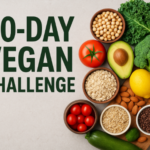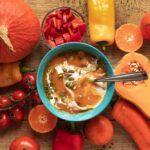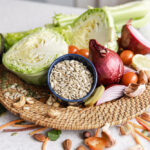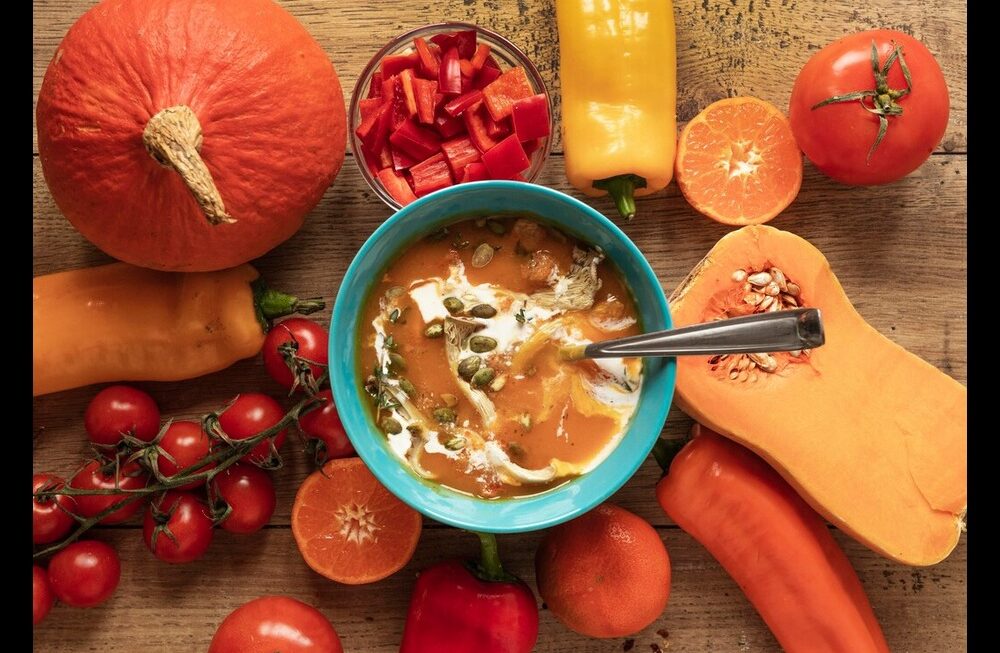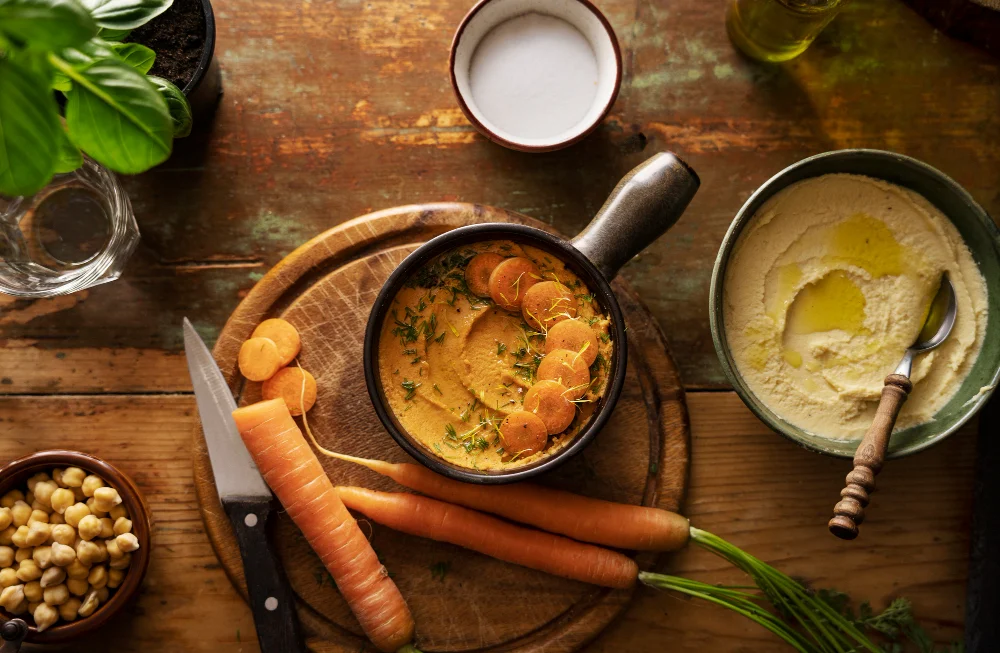Before supermarkets offered global produce year-round, eating was intrinsically tied to the land and its cycles. Eating with the seasons, a practice rooted in tradition and wisdom, involves choosing foods that are naturally harvested in your region at the current time of year. For vegans, this approach offers a pathway to meals that are not only compassionate but also bursting with peak flavour, maximum nutrition, often lower in cost, and significantly more sustainable. This guide explores the principles and delights of seasonal vegan recipes, analyzing the benefits through the lenses of nutrition, ethics, environment, and practical cooking, with specific inspiration for embracing the seasonal bounty available throughout the year – starting with the heat of early summer.
Best Seasonal Vegan Recipes Tips – Top Seasonal Eating Vegan Food
LENS 1: Nutritional Analysis (Peak Nutrition & Ayurvedic Alignment)

Consuming produce when it’s naturally in season offers distinct nutritional advantages and often aligns with principles for maintaining health throughout the year, as recognized in traditions like Ayurveda.
- Peak Nutrient Profile: Vegetables and fruits harvested at their natural peak of ripeness, having matured fully under optimal conditions, generally contain higher levels of vitamins, minerals, and beneficial phytonutrients (like antioxidants) compared to produce picked prematurely for long-distance shipping or grown out-of-season under artificial conditions. Seasonal eating ensures you get produce at its nutritional best.
- Seasonal Needs & Balance (Ayurvedic Perspective): Nature often provides what our bodies need during specific seasons:
- Summer (Grishma Ritu – Current Season in Vadodara): Characterized by heat (Pitta dosha increases). Nature offers cooling, hydrating foods. Focus on water-rich vegetables like cucumber (kakdi), bottle gourd (lauki), ridge gourd (tori), ash gourd, tomatoes (tamatar), and fruits like watermelon (tarbooz), melons (kharbooja), and the king of fruits, mango (aam)! Lighter cooking methods and cooling herbs like mint (pudina) are beneficial.
- Monsoon (Varsha Ritu – Upcoming): Humidity rises, digestive fire (Agni) can weaken, Vata dosha increases. Traditionally, easily digestible cooked foods are preferred. Corn (bhutta), gourds continue. Leafy greens might be avoided by some due to potential contamination, or cooked very well. Warming digestive spices (ginger, pepper) become more important.
- Autumn (Sharad Ritu): Pitta can still be present after monsoon. Transition period. Pumpkins (kaddu), squashes, and early cooler weather crops begin.
- Winter (Hemanta/Shishira Ritu): Cold and dry (Vata & Kapha increase). Body craves warmth and grounding nourishment. Seasonal bounty includes root vegetables (carrots/gajar, radish/mooli, beets/chukandar), abundant leafy greens (spinach/palak, fenugreek/methi, mustard greens/sarson ka saag), peas (matar), cauliflower (gobi), amla (Indian gooseberry – Vit C powerhouse!). Warming spices and healthy fats are beneficial. Ensuring adequate Vitamin D (less sun) is key.
- Fiber & Freshness: Seasonal produce, being fresher, often has better texture and higher fiber integrity. Seasonal vegan soups, stews, sabzis, and salads based on seasonal vegetables are naturally fiber-rich. Remember B12 must come from supplements/fortified foods. How does incorporating cooling seasonal foods like cucumber and melon feel nutritionally appropriate during Vadodara’s current hot weather?
Nutritional Deep Dive: Summer vs. Winter Vegan Nutrition with Seasonal Produce
- Summer Focus (Pitta Balancing): Prioritize hydration (melons, cucumber, gourds), cooling properties (mint, coriander, fennel), lighter meals (simple dals like moong, quick sabzis), sweet/bitter/astringent tastes. Use less chili, more cooling spices. Enjoy seasonal fruits like mangoes, watermelon.
- Winter Focus (Vata/Kapha Balancing): Prioritize warmth (soups, stews, porridges), grounding root vegetables, nourishing fats (nuts, seeds, moderate oil), warming spices (ginger, garlic, cloves, cinnamon, pepper), protein-rich legumes. Emphasize sweet, sour, salty tastes moderately. Utilize abundant leafy greens and crucifers. Ensure Vitamin D sources.
Voice of Experience (Ayurvedic Physician, Gujarat): “Eating seasonally, or Ritucharya, is fundamental in Ayurveda for maintaining doshic balance and strong Agni (digestion). Choosing cooling, hydrating vegan foods like lauki, kakdi, and aam during Gujarat’s intense summers pacifies Pitta. In winter, warm, nourishing meals with bajra roti, root vegetable sabzis, and warming spices balance Vata and Kapha. Nature provides the right medicine in each season.” – Vaidya Rakesh Patel, BAMS
LENS 2: Ethical Framework (Connecting with Cycles & Community)

Embracing seasonal eating extends vegan ethics beyond animal welfare to encompass community support, resource respect, and mindful consumption.
- Supporting Local Farmers: Choosing seasonal produce directly from local markets (mandis) or farmers in the Vadodara region provides them with crucial income, supports the local agricultural economy, and fosters a direct, transparent connection between consumer and producer. This contrasts with the often opaque and potentially exploitative conditions in long global supply chains.
- Respecting Natural Rhythms: Aligning eating habits with natural growing cycles demonstrates respect for nature’s limits and rhythms. It moves away from the expectation of having everything available year-round, regardless of the environmental or social cost.
- Reducing Food Waste: Seasonal eating naturally encourages using produce when it’s most abundant and often cheapest. This motivates learning preservation skills (pickling mangoes in summer, drying winter vegetables) or sharing excess bounty with neighbours and community, reducing the ethical problem of food waste.
- Mindful Appreciation: Eating seasonally fosters gratitude for the food that is available at a given time, enhancing appreciation for simple ingredients and the efforts involved in growing them.
- Festivals & Seasonality: Many Indian festivals are intrinsically linked to harvests and seasonal foods (e.g., Undhiyu with winter vegetables during Uttarayan in Gujarat). Celebrating these with seasonal vegan adaptations connects cultural traditions with compassionate, mindful eating. How does buying vegetables directly from a local vendor at the mandi feel different, ethically, compared to buying packaged produce in a supermarket?
Hidden Benefits: Simplicity & Connection
Focusing on seasonal availability simplifies grocery shopping and meal planning – you work with what’s good now. It also strengthens community ties when you engage with local producers and share seasonal vegan foods.
Voice of Experience (Slow Food Vadodara Member): “Eating seasonally is an ethical commitment to our local ecosystem and community. When we buy fresh turai or gavar from the mandi in summer, or crisp mooli and palak in winter, we support Gujarati farmers directly, reduce food miles, and taste food as it’s meant to be eaten – fresh, flavourful, and connected to the land.” – Mrs. Bharati Shah, Slow Food Advocate
Critical Reassessment: Modern Challenges & Balancing Act
While ideal, strictly seasonal eating can be challenging in modern life due to globalized food systems making off-season produce readily available (though often less flavourful/sustainable). Price fluctuations can occur, and access to diverse local produce might vary. A practical approach involves prioritizing seasonal and local while supplementing with necessary staples available year-round.
LENS 3: Ingredient Science & Environment (Eco-Logical Eating)
The science behind seasonal produce and its environmental advantages makes eating with the seasons a deeply logical and sustainable choice.
- Peak Flavour Science: Flavour compounds, sugars, and aromatic volatiles in fruits and vegetables develop most fully during natural ripening on the plant under optimal climate conditions. Produce picked early and transported long distances often lacks this peak flavour potential. Seasonal = Tastier!
- Texture & Water Content: Seasonal variations impact cooking. Summer vegetables (gourds, cucumber, tomatoes) have high water content, suiting quicker cooking or raw preparations. Winter root vegetables (carrots, potatoes, beets) are denser, starchier, benefiting from slower cooking (stews, roasting) to tenderize and concentrate flavours.
- Major Environmental Wins:
- Reduced Food Miles: Eating locally grown seasonal food drastically cuts down on energy consumption and greenhouse gas emissions associated with long-distance road, sea, or air transport.
- Lower Energy Inputs: Reduces the need for energy-intensive practices like heated greenhouses for growing warm-weather crops in winter, or long-term refrigerated storage and artificial ripening for off-season produce.
- Water Conservation: Choosing crops naturally suited to the season and local climate (like water-efficient millets and certain gourds during drier periods in Gujarat/Rajasthan) utilizes rainfall more effectively and reduces strain on irrigation resources compared to growing thirsty crops out of season.
- Supports Biodiversity & Soil Health: Encourages farmers to grow diverse crops suited to local conditions and seasonal rotations, rather than focusing on a few high-demand global monoculture crops year-round.
- Combining with Low-Impact Staples: Pairing seasonal vegetables with inherently low-footprint vegan staples like lentils (dal), chickpeas (chana), or local millets (bajra, jowar) creates meals with an exceptionally small environmental impact. Think about a vegetable you enjoy year-round – how might its environmental footprint differ when bought locally in season versus imported off-season?
Voice of Experience (Environmental Scientist, Food Systems): “The environmental argument for seasonal, local eating is compelling. It minimizes transport emissions, reduces energy demand for storage and artificial growing conditions, conserves water by aligning crops with climate, and supports regional agricultural biodiversity. It’s a cornerstone of building a sustainable food future, particularly in resource-conscious regions.” – Dr. Alok Sharma, Sustainable Agriculture Institute
LENS 4: Everyday Practitioner’s Experience (Recipes & Adapting Through the Year)

Bringing seasonal eating into your vegan kitchen is about observation, flexibility, and embracing the unique offerings of each time of year.
Finding & Using Seasonal Produce in Vadodara/Gujarat:
- Visit Local Mandis: The best way! See what vendors have in abundance; it’s almost certainly in season and locally grown. Talk to the vendors. Prices will be lower for seasonal items.
- Observe Your Surroundings: Notice what fruits are ripening on local trees or what vegetables neighbours might be growing.
- Seasonal Calendar (Approximate Guide for Vadodara/Gujarat):
- Summer (Apr-June): Mangoes (Aam), Watermelon (Tarbooz), Muskmelon (Kharbooja), Lychee, Bottle Gourd (Lauki), Ridge Gourd (Tori/Turai), Bitter Gourd (Karela), Okra (Bhindi), Cluster Beans (Guar Phali), Tindora (Ivy Gourd), Tomatoes, Onions, Cucumber (Kakdi), Peppers (Shimla Mirch), Brinjal (Baingan).
- Monsoon (July-Sept): Corn (Bhutta), Cucumber, Gourds continue, some Leafy Greens (use cautiously), Okra, Brinjal, Tomatoes.
- Winter (Nov-Feb): Carrots (Gajar), Radish (Mooli), Beets (Chukandar), Cauliflower (Gobi), Cabbage (Patta Gobhi), Peas (Matar), Spinach (Palak), Fenugreek leaves (Methi), Mustard Greens (Sarson), Green Garlic, Amla (Gooseberry), Guava (Jamphal), Oranges (Santra), Pomegranate (Anar).
- Spring (Mar-Apr): Transition period, some winter greens might linger, early summer vegetables start.
Seasonal Vegan Recipe Ideas & Techniques:
- Summer (Focus: Cooling, Quick Cooking):
- Lauki Chana Dal: Bottle gourd cooked with split chickpeas, simple spices.
- Bhindi Masala (Dry): Okra stir-fried with onions, tomatoes, spices (cook okra first to reduce slime).
- Kachumber Salad: Finely chopped cucumber, tomato, onion with lemon juice, coriander, salt, maybe chaat masala.
- Vegan Mango Lassi/Smoothie: Blend ripe mangoes with plant yogurt/milk and cardamom.
- Raw Mango Rice (Kairi Bhat): Rice flavoured with tempered spices and grated raw mango.
- Monsoon (Focus: Digestible, Cooked):
- Corn Sabzi/Soup: Sweet corn kernels cooked with mild spices.
- Steamed/Sautéed Greens: If using greens, cook them well, perhaps with garlic tadka.
- Simple Dal Khichdi: Easy to digest rice and moong dal porridge.
- Winter (Focus: Warming, Hearty):
- Vegan Sarson ka Saag: Mustard greens & spinach stew, thickened with maize flour, tempered with garlic/ginger/onion. Serve with Makki/Bajra Roti.
- Gajar Matar Sabzi: Sweet winter carrots and peas in a tomato-onion gravy.
- Hearty Mixed Dal: Combination of lentils slow-cooked or pressure-cooked into a thick stew.
- Roasted Root Vegetables: Carrots, potatoes, beets tossed with oil and spices, roasted until tender.
- Vegan Undhiyu (Gujarati Special): Complex mixed vegetable dish with winter produce like papdi beans, potatoes, sweet potatoes, eggplant, bananas, cooked with methi muthia (fenugreek dumplings – use oil/vegan yogurt) and spices. Requires specific ingredients/technique.
Adapting Recipes Seasonally:
- Basic Sabzi Formula: Use the same tadka (mustard/cumin seeds, hing, turmeric, chili) and onion-ginger-garlic base, but swap the main vegetable(s) based on what’s in season.
- Dal Variations: Add seasonal vegetables like spinach or lauki to your everyday dal.
- Soup Flexibility: Use seasonal vegetables as the base for pureed soups or chunky stews.
What seasonal vegetable currently abundant in Vadodara markets could you feature in a simple vegan sabzi or dal this week?
Daily Impact: The Seasonal Kitchen Mindset
Shift from planning meals based on cravings for specific out-of-season vegetables to planning based on what looks best and most abundant at the local market today. This reduces cost and increases flavour.
Voice of Experience (Vadodara Home Cook): “My cooking totally changes with the seasons here! Summer means lots of quick sabzis with lauki, turai, bhindi, and refreshing kachumber. Winter is for hearty undhiyu, sarson ka saag, and sweet gajar ka halwa. Buying from the mandi is key – you see what’s truly fresh and affordable right now.” – Mrs. Jignasha Patel, Homemaker
Alternative Approaches: Preservation & Flexibility
- Preserving: Can, pickle (achar), dry, or freeze abundant seasonal produce to enjoy flavours year-round (e.g., making mango pickle in summer, drying methi in winter).
- Flexibility: While prioritizing seasonal/local, accept the need for some year-round staples (onions, potatoes, garlic, lentils, rice) and occasional non-local items for variety or specific recipes. Aim for a majority seasonal approach.
PERSPECTIVE INTERSECTION MATRIX
- Nutrition & Seasonality (Lens 1 & 4): Eating seasonal produce (Lens 4) naturally provides peak nutrient levels (Lens 1) and aligns with Ayurvedic principles for seasonal balance (Lens 1).
- Ethics & Local Buying (Lens 2 & 4): Ethical support for local farmers (Lens 2) is put into practice by prioritizing seasonal produce from local markets (Lens 4). Reducing waste (Lens 2) involves using seasonal gluts creatively (Lens 4).
- Environment & Food Miles (Lens 3 & 4): The significant environmental benefit of reduced food miles (Lens 3) is achieved through the practical habit of cooking with local, seasonal ingredients (Lens 4).
- Science & Flavour (Lens 3 & 4): Understanding that peak flavour develops during natural ripening (Lens 3) encourages practitioners to seek out and utilize seasonal produce for best culinary results (Lens 4).
- Practicality & All Factors (Lens 4 & 1/2/3): Cooking seasonally (Lens 4) is often the most practical approach, naturally leading to better nutrition (Lens 1), lower costs (Lens 4), ethical local support (Lens 2), and reduced environmental impact (Lens 3).
MISCONCEPTION ANALYSIS
| Misconception | Reality |
| Eating only seasonal vegan food is boring and overly restrictive. | It encourages rotating variety throughout the year! You fully enjoy mangoes in summer, relish winter greens when they arrive, etc. It fosters creativity in using the ingredients that are currently at their absolute best, preventing year-round monotony. |
| It’s difficult to know what’s actually in season where I live. | Your local market (mandi) is the best guide! Observe what’s abundant, fresh-looking, and generally cheapest. Ask the vendors. Local online resources or agricultural calendars for your region (Gujarat/Western India) can also help. |
| Seasonal, local, or organic produce is always more expensive. | Often, produce bought in season directly from local markets is significantly cheaper than out-of-season produce shipped long distances or grown in greenhouses, even if it’s not certified organic. Abundance drives down price. |
| I can’t make my favourite vegan recipes if key ingredients aren’t in season. | This encourages adaptation! Learn to substitute seasonal vegetables in basic formulas (dals, sabzis, stir-fries). Or, enjoy those specific recipes as special treats when the ingredients are in season, making them even more anticipated. Preservation helps too. |
| Veganism itself is already restrictive; adding seasonality is too much. | Viewing seasonality not as restriction but as an opportunity for peak flavour, nutrition, cost savings, and sustainability reframes it. It enhances the vegan experience by connecting it more deeply to natural cycles and local resources. |
KEY TURNING POINTS
- Pre-Industrial Norm: Seasonality was the only way to eat for most of human history.
- Globalization & Refrigeration: Created the illusion of year-round availability for most produce, disconnecting consumers from seasons.
- Slow Food Movement (1980s onwards): Re-emphasized the importance of local, seasonal, traditional foodways as a counter to fast food culture.
- Farmers’ Market Resurgence: Provided consumers direct access to local growers and seasonal produce, fostering awareness.
- Chef-Driven Seasonality: High-profile chefs building menus around seasonal ingredients raised its profile and desirability.
- Environmental Awareness: Concepts like “food miles” and the carbon footprint of agriculture highlighted the sustainability benefits of eating locally and seasonally.

SYNTHESIS & RECOMMENDATIONS
Embracing seasonal vegan recipes and eating with the seasons is a delightful return to a more natural, flavourful, sustainable, and often more affordable way of eating. By aligning your vegan kitchen with the agricultural rhythms of your region – celebrating mangoes and gourds in Vadodara’s summers, and hearty greens and root vegetables in winter – you unlock peak nutrition and taste while supporting local farmers and minimizing your environmental impact. It transforms cooking from following rigid recipes to creatively engaging with the fresh, abundant ingredients available right now. Let the seasons guide your compassionate plate!
Recommendations for Eating Seasonally (Vegan Style):
- Shop Local Markets (Mandis): Make visiting your local vegetable market in Vadodara a regular habit. See what’s abundant and fresh – that’s your cue!
- Learn Your Local Seasons: Familiarize yourself with the general growing seasons for common vegetables and fruits in Gujarat/Western India.
- Be Flexible with Recipes: Learn basic cooking formulas (dal, sabzi, stir-fry) and practice swapping the main vegetables based on seasonal availability.
- Prioritize Seasonal: Make seasonal produce the star of your meals. Supplement with year-round staples (lentils, rice, potatoes, onions) and occasional non-local items for variety.
- Preserve the Bounty: Learn simple vegan preservation techniques (pickling, drying, freezing) to enjoy peak-season flavours later (e.g., make mango achar now!).
- Connect with Growers: Talk to vendors at the mandi; ask where produce comes from and what’s coming into season next.
- Celebrate Each Season’s Flavours: Look forward to specific dishes you can only make when certain ingredients are at their best (like Undhiyu in winter).
- Cook Simply: Often, the best way to enjoy peak-season produce is through simple preparations that let its natural flavour shine.



